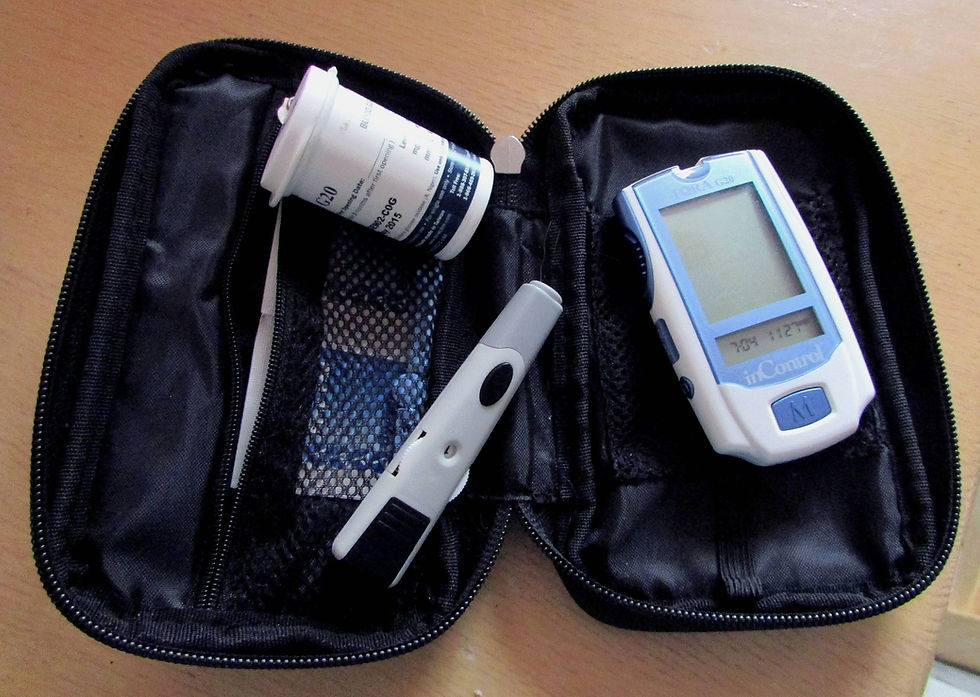Understanding High Blood Sugar (Hyperglycemia): Causes, Symptoms, and Natural Management Tips
- Gillian Scerri

- Jul 3
- 4 min read
Updated: Oct 2
High blood sugar, medically known as hyperglycemia, occurs when glucose levels in the bloodstream rise above normal. This condition is common among people with diabetes, especially if the disease is not properly managed. Persistent hyperglycemia can lead to serious health complications, so understanding how to recognise and control it is vital for your well-being.

What Is Hyperglycemia?
Hyperglycemia happens when your body either doesn't produce enough insulin or cannot effectively use the insulin it produces. Insulin is the hormone responsible for regulating blood sugar. Without proper insulin function, sugar accumulates in the blood instead of being used for energy.
Common Symptoms of High Blood Sugar:
Excessive thirst
Weakness and fatigue
Headaches
Frequent urination
Blurred vision
Nausea
Shortness of breath
If you notice these symptoms consistently, it’s important to consult a healthcare professional for evaluation and treatment.
The Role of Glycemic Index and Glycemic Load in Managing Blood Sugar
When managing blood sugar, understanding the glycemic index (GI) and glycemic load (GL) of foods can be incredibly helpful. The GI measures how much a 50g portion of a carbohydrate raises blood glucose. However, since we rarely eat exactly 50g of carbs from a single food, the GI doesn’t always provide the full picture.
The glycemic load offers a more accurate view because it considers both the quality (GI) and quantity of carbohydrates eaten. For example, watermelon has a high GI of 72 but a low GL of 4 because a typical serving contains fewer digestible carbs, resulting in a minimal impact on blood sugar.
Foods to Avoid for Stable Blood Sugar
To maintain balanced blood sugar, try to avoid:
Processed Sugary Products
These cause sharp blood sugar spikes followed by crashes, leading to mood swings and adrenal and thyroid dysfunction. Stable blood sugar is a hallmark of people who live long, healthy lives.
Corn-Fed Meat
Corn-fed cattle have high omega-6 fats, which are pro-inflammatory and can spike blood sugar. Opt for grass-fed, organic meat, which contains healthier omega-3 fats and more antioxidants.
Caffeine and Dehydration
Caffeine causes blood sugar swings and mineral depletion, increasing sugar cravings. Often, sweet cravings are signs of dehydration. Try drinking water first before reaching for sugary snacks.
Refined Grains and High Amylopectin Foods
Refined grains and foods high in amylopectin (a rapidly digestible starch) can cause quick blood sugar spikes. These include:
White rice and sticky/glutinous rice
White bread
Potatoes (especially mashed or baked)
Pastries, cakes, cookies
Breakfast cereals like cornflakes and puffed rice
Corn-based snacks like tortilla chips and popcorn
Better Food Choices for Blood Sugar Control
Low Glycemic and Fiber-Rich Options
Whole grains: Quinoa, barley, steel-cut oats (paired with protein like hemp seeds, chia seeds, kefir, and nuts)
Legumes: Lentils, chickpeas, black beans
Sweet potatoes (boiled and eaten in moderation)
Brown rice (moderate glycemic load)
Non-starchy vegetables: Broccoli, spinach, zucchini
Whole fruits: Berries, apples with skin (fiber slows sugar absorption)
Foods That Help Lower Blood Sugar:
Ceylon cinnamon: Use 1 teaspoon daily to improve insulin sensitivity and blood sugar control.
Allium vegetables: Onion, garlic, shallots, leeks help manage fasting blood glucose.
Fiber-rich foods: Aim for 25 grams of fiber daily from fruits, vegetables, and gluten-free whole grains.
Helpful Lifestyle Tips for Managing Blood Sugar
Start your day with protein like eggs to promote satiety and regulate blood sugar.
Eat your vegetables first, then protein, then carbs to reduce blood sugar spikes.
Replace sugar with natural sweeteners like stevia or monk fruit (ensure they do not contain erythritol).
Maintain balanced meals with protein, fats, and carbs to stabilise blood sugar.
Stay hydrated by drinking at least 2 liters of filtered or spring water daily.
Exercise regularly: Start with 10 minutes daily (walking, yoga) and increase as your energy improves to help balance blood sugar and reduce cravings.
Avoid fasting or low-carb dieting when stressed to support adrenal and brain function.
Natural Supplements That Support Blood Sugar Balance
Magnesium Bisglycinate Chelate (400 mg daily): Helps improve insulin sensitivity and reduce inflammation.
Alpha Lipoic Acid (300 mg twice daily): An antioxidant that aids glucose metabolism and nerve health.
Berberine (500 mg twice daily): A plant extract that lowers blood sugar and supports overall metabolic health.
Additional Natural Remedies
Turmeric: 1 teaspoon daily with fat and black pepper boosts absorption and reduces inflammation.
Apple Cider Vinegar (ACV): 1 teaspoon before meals lowers blood sugar response.
Lemon juice: Can reduce blood sugar spikes when added to meals.
Managing high blood sugar doesn’t have to rely solely on medication. With the right dietary choices, lifestyle habits, and natural supplements, you can support your body’s ability to regulate blood sugar effectively. Remember, consistency is key, small daily changes add up to big improvements over time.
If you have diabetes or suspect you might, always consult with your healthcare provider before making major changes to your diet or supplement routine.
For more expert tips on holistic nutrition, weight loss, and wellness, feel free to browse the rest of my blog posts. You’ll find practical advice on gut health, emotional eating, energy-boosting foods, and more.
Stay inspired and follow along on Instagram at @align.holistic.nutrition, for daily tips, real-life nutrition insights, and healthy living ideas.
Ready to take control of your health? Learn more about my online nutrition coaching services via the link below and see how we can work together to help you feel your best, inside and out!




Comments